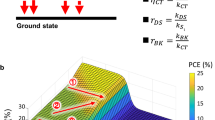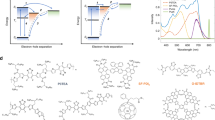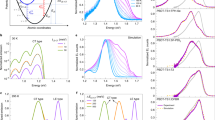Abstract
Organic solar cells utilize an energy-level offset to generate free charge carriers. Although a very small energy-level offset increases the open-circuit voltage, it remains unclear how exactly charge generation is affected. Here we investigate organic solar cell blends with highest occupied molecular orbital energy-level offsets (∆EHOMO) between the donor and acceptor that range from 0 to 300 meV. We demonstrate that exciton quenching at a negligible ∆EHOMO takes place on timescales that approach the exciton lifetime of the pristine materials, which drastically limits the external quantum efficiency. We quantitatively describe this finding via the Boltzmann stationary-state equilibrium between charge-transfer states and excitons and further reveal a long exciton lifetime to be decisive in maintaining an efficient charge generation at a negligible ∆EHOMO. Moreover, the Boltzmann equilibrium quantitatively describes the major reduction in non-radiative voltage losses at a very small ∆EHOMO. Ultimately, highly luminescent near-infrared emitters with very long exciton lifetimes are suggested to enable highly efficient organic solar cells.
This is a preview of subscription content, access via your institution
Access options
Access Nature and 54 other Nature Portfolio journals
Get Nature+, our best-value online-access subscription
$29.99 / 30 days
cancel any time
Subscribe to this journal
Receive 12 digital issues and online access to articles
$119.00 per year
only $9.92 per issue
Buy this article
- Purchase on Springer Link
- Instant access to full article PDF
Prices may be subject to local taxes which are calculated during checkout






Similar content being viewed by others
Data availability
All data generated or analysed during this study are included in the published article and its Supplementary Information data files. Source data are provided with this paper.
References
Green, M. A. et al. Solar cell efficiency tables (Version 53). Prog. Photovolt. 2, 3–12 (2019).
Xu, X. et al. Single‐junction polymer solar cells with 16.35% efficiency enabled by a platinum(ii) complexation strategy. Adv. Mater. 31, 1901872 (2019).
Liu, Z. et al. Open-circuit voltages exceeding 1.26 V in planar methylammonium lead iodide perovskite solar cells. ACS Energy Lett. 1, 110–117 (2018).
Polman, A., Knight, M., Garnett, E. C., Ehrler, B. & Sinke, W. C. Photovoltaic materials: present efficiencies and future challenges. Science 352, aad4424 (2016).
Geisz, J. F., Steiner, M. A., García, I., Kurtz, S. R. & Friedman, D. J. Enhanced external radiative efficiency for 20.8% efficient single-junction GaInP solar cells. Appl. Phys. Lett. 103, 0–5 (2013).
Miller, O. D., Yablonovitch, E. & Kurtz, S. R. Intense internal and external fluorescence as solar cell approach the SQ efficiency limit. IEEE J. Photovolt. 2, 1–27 (2012).
Deibel, C. & Dyakonov, V. Polymer–fullerene bulk heterojunction solar cells. Rep. Prog. Phys. 73, 96401 (2010).
Green, M. A. et al. Solar cell efficiency tables (version 50). Prog. Photovolt. Res. Appl. 25, 668–676 (2017).
Zheng, Z. et al. Efficient charge transfer and fine-tuned energy level alignment in a THF-processed fullerene-free organic solar cell with 11.3% efficiency. Adv. Mater. 29, 1604241 (2017).
Qian, D. et al. Design rules for minimizing voltage losses in high-efficiency organic solar cells. Nat. Mater. 17, 703–709 (2018).
Eisner, F. et al. Hybridization of local exciton and charge-transfer states reduces non-radiative voltage losses in organic solar cells. J. Am. Chem. Soc. 141, 6362–6374 (2019).
Holliday, S. et al. High-efficiency and air-stable P3HT-based polymer solar cells with a new non-fullerene acceptor. Nat. Commun. 7, 11585 (2016).
Lin, Y. et al. An electron acceptor challenging fullerenes for efficient polymer solar cells. Adv. Mater. 27, 1170–1174 (2015).
Yuan, J. et al. Single-junction organic solar cell with over 15% efficiency using fused-ring acceptor with electron-deficient core. Joule 3, 1–12 (2019).
Fan, B. et al. Achieving over 16% efficiency for single-junction organic solar cells. Sci. China Chem. https://doi.org/10.1007/s11426-019-9457-5 (2019).
Sweetnam, S. et al. Characterization of the polymer energy landscape in polymer:fullerene bulk heterojunctions with pure and mixed phases. J. Am. Chem. Soc. 136, 14078–14088 (2014).
Dong, Y. et al. The binding energy and dynamics of charge-transfer states in organic photovoltaics with low driving force for charge separation. J. Chem. Phys. 150, 104704 (2019).
Xie, Y. et al. Assessing the energy offset at the electron donor/acceptor interface in organic solar cells through radiative efficiency measurements. Energy Environ. Sci. 12, 3556–3566 (2019).
Falke, S. M. et al. Coherent ultrafast charge transfer in an organic photovoltaic blend. Science 344, 1001–1005 (2014).
Howard, I. A., Mauer, R., Meister, M. & Laquai, F. Effect of morphology on ultrafast free carrier generation in polythiophene:fullerene organic solar cells. J. Am. Chem. Soc. 132, 14866–14876 (2010).
Ziffer, M. E. et al. Long-lived, non-geminate, radiative recombination of photogenerated charges in a polymer/small-molecule acceptor photovoltaic blend. J. Am. Chem. Soc. 140, 9996–10008 (2018).
Gélinas, S. et al. Ultrafast long-range charge separation in organic semiconductor photovoltaic diodes. Science 343, 512–516 (2014).
Vandewal, K., Benduhn, J. & Nikolis, V. C. How to determine optical gaps and voltage losses in organic photovoltaic materials. Sustain. Energy Fuels 2, 538–544 (2018).
Rau, U., Blank, B., Müller, T. C. M. & Kirchartz, T. Efficiency potential of photovoltaic materials and devices unveiled by detailed-balance analysis. Phys. Rev. Appl. 7, 1–9 (2017).
Classen, A. et al. Absence of charge transfer state enables very low VOC losses in SWCNT:fullerene solar cells. Adv. Energy Mater. 9, 1801913 (2018).
Kirchartz, T. & Rau, U. Detailed balance and reciprocity in solar cells. Phys. Satus Solidi Mater. Sci. 205, 2737–2751 (2008).
Rau, U. Reciprocity relation between photovoltaic quantum efficiency and electroluminescent emission of solar cells. Phys. Rev. B 76, 085303 (2007).
Benduhn, J. et al. Intrinsic non-radiative voltage losses in fullerene-based organic solar cells. Nat. Energy 2, 17053 (2017).
Heiber, M. C., Baumbach, C., Dyakonov, V. & Deibel, C. Encounter-limited charge-carrier recombination in phase-separated organic semiconductor blends. Phys. Rev. Lett. 114, 136602 (2015).
Lopez, S. A., Sanchez-Lengeling, B., de Goes Soares, J. & Aspuru-Guzik, A. Design principles and top non-fullerene acceptor candidates for organic photovoltaics. Joule 1, 857–870 (2017).
Burkhard, G. F., Hoke, E. T. & McGehee, M. D. Accounting for interference, scattering, and electrode absorption to make accurate internal quantum efficiency measurements in organic and other thin solar cells. Adv. Mater. 22, 3293–3297 (2010).
Bronstein, H. et al. Indacenodithiophene-co-benzothiadiazole copolymers for high performance solar cells or transistors via alkyl chain optimization. Macromolecules 44, 6649–6652 (2011).
Biniek, L. et al. Optimization of the side-chain density to improve the charge transport and photovoltaic performances of a low band gap copolymer. Org. Electron. 13, 114–120 (2012).
Biniek, L. et al. 3,6-Dialkylthieno[3,2-b]thiophene moiety as a soluble and electron donating unit preserving the coplanarity of photovoltaic low band gap copolymers. J. Polym. Sci. A 50, 1861–1868 (2012).
Risko, C., McGehee, M. D. & Brédas, J. L. A quantum-chemical perspective into low optical-gap polymers for highly-efficient organic solar cells. Chem. Sci. 2, 1200–1218 (2011).
Ku, J., Lansac, Y. & Jang, Y. H. Time-dependent density functional theory study on benzothiadiazole-based low-band-gap fused-ring copolymers for organic solar cell applications. J. Phys. Chem. C 115, 21508–21516 (2011).
Chochos, C. L. et al. Experimental and theoretical investigations on the optical and electrochemical properties of π-conjugated donor–acceptor–donor (DAD) compounds toward a universal model. J. Chem. Phys. 149, 124902 (2018).
Acknowledgements
A.C. and C.J.B. gratefully acknowledge funding from the Deutsche Forschungsgemeinschaft (DFG, German Research Foundation), Project no. 182849149-SFB 953. C.J.B. gratefully acknowledges financial support through the ‘Aufbruch Bayern’ initiative of the state of Bavaria (EnCN and SFF) and the Bavarian Initiative ‘Solar Technologies go Hybrid’ (SolTech) and funding from DFG project DFG INST 90/917. C.C.L. thanks the European Union for the financial support. This project has received funding from the European Union’s Horizon 2020 research and innovation programme under grant agreements no. 761112 (PRESTIGE) and no. 820789 (OLEDSOLAR).
Author information
Authors and Affiliations
Contributions
T.H. and C.J.B. conceived the idea for this study and supervised the work. A.C. fabricated all the measured devices and samples, performed J–V characterizations, EQE measurements, FTPS spectroscopy, CV measurements and absorbance measurements. C.L.C. and V.G.G. synthesized the polymers used in this work and performed the DFT calculations. A.O. and A.C. performed the TRPL measurements. J.W. and A.C. performed the steady-state PL and EL measurements. K.F. performed the optical transfer-matrix calculation of IQE. L.L. developed the effective two-states model and utilized this theoretical framework to fit the experimental data. T.H., I.M., C.J.B. and A.C. evaluated and interpreted the experimental findings. The manuscript was written and commented on by all the authors.
Corresponding authors
Ethics declarations
Competing interests
The authors declare no competing interests.
Additional information
Publisher’s note Springer Nature remains neutral with regard to jurisdictional claims in published maps and institutional affiliations.
Supplementary information
Supplementary Information
Supplementary Figs. 1–38, Tables 1–5, Notes 1–4 and refs. 1–9.
Supplementary Data 1
Supplementary Data for Supplementary Table 3
Source data
Source Data Fig. 2
Source Data Fig. 2.
Source Data Fig. 3
Source Data Fig. 3.
Source Data Fig. 4
Source Data Fig. 4.
Source Data Fig. 5
Source Data Fig. 5.
Source Data Fig. 6
Source Data Fig. 6.
Rights and permissions
About this article
Cite this article
Classen, A., Chochos, C.L., Lüer, L. et al. The role of exciton lifetime for charge generation in organic solar cells at negligible energy-level offsets. Nat Energy 5, 711–719 (2020). https://doi.org/10.1038/s41560-020-00684-7
Received:
Accepted:
Published:
Issue Date:
DOI: https://doi.org/10.1038/s41560-020-00684-7
This article is cited by
-
Physical insights into non-fullerene organic photovoltaics
Nature Reviews Physics (2024)
-
The role of interfacial donor–acceptor percolation in efficient and stable all-polymer solar cells
Nature Communications (2024)
-
Origins of the open-circuit voltage in ternary organic solar cells and design rules for minimized voltage losses
Nature Energy (2023)
-
Models and mechanisms of ternary organic solar cells
Nature Reviews Materials (2023)
-
Conventional and Metal Oxide-Based Inverted Polymer Solar Cells: A Comparative Experimental Study
Journal of Electronic Materials (2023)



